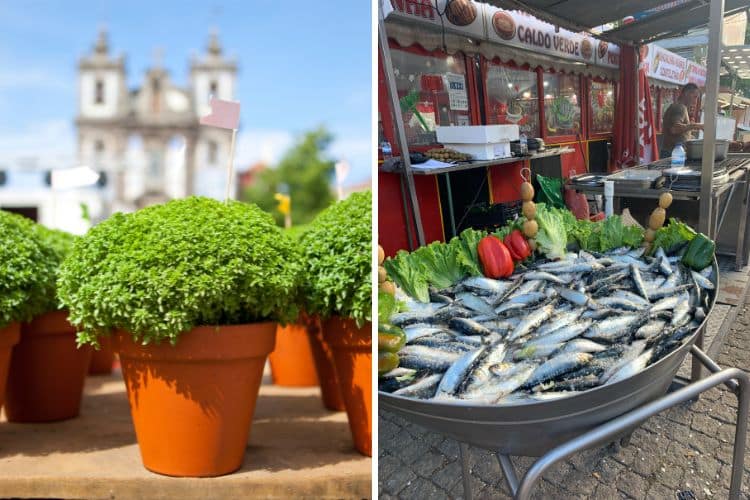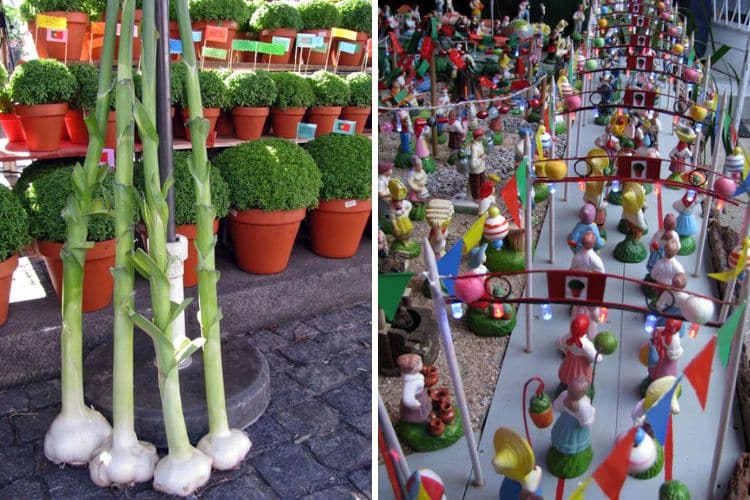16 de June, 2024

In June, the Portuguese celebrate the Popular Saints, a series of festivities in honor of São Gonçalo, Santo Antônio, São João and São Pedro. These events are marked by masses, processions, marches and lots of partying. The festive calendar begins with the festivities to Saint Gonçalo, on the first weekend of the month, in Amarante and region. Next is the feast in honor of Saint Anthony, a saint much loved by the Lisboans, which lasts from the 12th to the 13th, which is a holiday in the city. On the night of June 23 to 24, the Saint John Festival (São João Festival) takes place in OPorto. Finally, at the end of the month, between June 28 and 29, several cities in the country celebrate Saint Peter.
In this article we will talk specifically about the São João Party in Portugal, which mainly take place in Vila Nova de Gaia, Braga and especially in Porto being the largest event in this city with significant popular participation. This celebration, which enchants locals and tourists alike, brings together a series of interesting traditions and curiosities, as we will see below.

Although it is a Catholic feast, intended to celebrate the birth of Saint John the Baptist, the truth is that this commemoration has pagan origin. Originally, it marked the beginning of the summer solstice and fertility, as well as harvests and abundance. Around the 15th century, the Church Christianised this feast by dedicating it to St John.
It was only after the 20th century that São João Festival evolved into the format we know today. Only after the revolution of October 5, 1910 , did the 24th of June start to be considered a municipal holiday in the city of Porto. as a municipal holiday in the city of Porto.
Learn how the Portuguese celebrate Carnaval!
St. John the Baptist was a Jewish preacher who was a contemporary of Jesus Christ . He became eternalized for, among other reasons, having baptized Jesus. John the Baptist and Jesus were cousins. Both were announced to their respective mothers, Elizabeth and Mary, by the angel Gabriel.
It is worth pointing out that Saint John is not the patron saint of the city, as many believe. The patron saint of OPorto is Nossa Senhora da Vandoma!
Realizing your goal of living in Europe or obtaining European citizenship can be simpler than you think. We offer personalized support to make the immigration process more accessible and uncomplicated.
Porto begins to prepare for São João festivities well in advance.
Special lighting and decorations are installed throughout the alleys of the Historic Center, featuring streamers, basil plants (“manjericos”), and other symbols related to the occasion.
Music takes over the streets. Stages are set up across the city. Various neighborhoods host “bailaricos,” lively dance parties with food and drinks. The so-called folklore groups (“ranchos folclóricos”) take over the main squares, performing traditional music and dances in typical attire.
On the night of June 23, Porto’s sky lights up with small hot air balloons, while the Luiz I Bridge and the Ribeira district are filled with fireworks and music. The colorful balconies of Porto’s downtown turn into mini stages for DJs. Carousels occupy the squares, bringing joy to children.
Food trucks (called rulotes) line the streets, offering a variety of foods. Speaking of food, traditional grilled sardines and peppers are a staple, their aroma filling the city streets.
Finally, small plastic hammers and real leeks almost take on a starring role. They are used to greet passersby and even as a way to court beautiful women.
See here the complete program of São João Festival in OPorto in 2024 !

The sardine is the greatest symbol of the popular saints’ festivities. They are grilled on the coals, in the street. Not only by traders, but also by groups of friends and neighbors. Everyone wants to set up their own grill to participate in the feast!
It is also common to roast paprika and entremeada (a cut of pork belly) on the coals. Roast kid, caldo verde (green broth) and bifana on bread are also on the menu at the São João Festival. The rulotes, spread all over the city, offer everything from hot dogs to farturas (sweet fried dough similar to the Spanish churro).
The most traditional drinks are wine and traditional beer.
Discover typical Portuguese dishes
Throughout the city there will be pots of basil, a plant of the basil family (and similar aroma), but with tiny leaves. You cannot smell basil directly by bringing your nose close to the plant, as it is believed that this can dry and kill the plant. As a rule, one should touch the basil and smell it with one’s hand. According to tradition, basil is one of the ways that lovers use to propose to each other. In former times, this offering worked as a commitment as strong as a marriage proposal. The pots usually bear small flags with poems, with four verses in cross-rhyme, i.e. the 1st verse rhymes with the 3rd and the 2nd with the 4th. These verses help to confess love.

The tradition of sniffing leeks, touching them to the noses of those around, is believed to date back to time immemorial, long before the Christian era. And it exists to this day, being used as a greeting among revellers. But over the years, it has been superseded by the little hammers, used for the same purpose.
The two-sided hammers, equipped with whistles, traditionally used in São João, were created in the 60’s, by a factory in Gondomar, on the outskirts of the city of Porto, as another toy of the brand. At the same time of its creation, they were used by a group of students from the University of Porto, in the traditional university party known as Queima das Fitas. The success was immediate, with students hammering each other all day long. Soon the shopkeepers in Porto were ordering hammers for the São João Festivities that took place a few weeks later. From then on the popularization was inevitable, despite the attempt to ban the use of the accessory in the 70s. If you go out on the streets that night, be sure to bring a small hammer. And be prepared to get hammered all night long!
The cascades are a kind of nativity scene with sculptures, only made especially for the celebration of São João in Porto. They illustrate the different arts, crafts and architecture of the city, and have typical elements and characters: the church, the priest, the procession and, mainly, the mijona and the cagão. The mijona is a little doll peeing in a jug of milk and the cagão (big shit) is lowered without his trousers.
The São João cascades occupy many of the oldest streets in the city, houses, and also shop facades. There is even a contest to elect the most beautiful one. They also contain a fountain or a small dish for people to leave a donation coin.
In 2024, if you wish to see a beautiful collective cascade on display, visit the historic Bolhão Market between June 12 and 30. Another famous São João cascade in the city is located in front of the Church of Taipas.
Pimba music is a type of Portuguese popular music, inspired by folk music, with lyrics full of puns with sexual meanings or simplistic romantic sentimentality. The term is relatively recent. It would have appeared in 1995 , because of a song called “Pimba, pimba”, a popular ‘hit’ by the singer Emanuel, which sold more than half a million copies. It was then that the word “pimba” began to designate a whole range of songs of the genre.
The bailaricos, on the other hand, are popular music balls, with free access, which are spread throughout the city at this time of year.
In the month of June, presentations and parades of folkloric groups from various cities in the country also take place in the streets of Porto, especially on weekends. These are called folkloric ranchos, artistic groups dedicated to the preservation and promotion of traditional Portuguese folk culture. They are composed of a group of people, dressed in typical costumes, who come together to sing, dance and play music, representing the traditions and customs of different regions.

Around midnight, the Porto Alegre sky is lit up with small hot air balloons, creating a spectacle of lights. This practice may seem a bit frightening to those coming from Brazil, where releasing balloons has been forbidden for decades. However, here in Portugal, it is a common tradition and generally allowed. It is important to note that when the weather conditions are not suitable (too low humidity), the Portuguese government prohibits the practice to avoid more serious incidents.
Balloons and bonfires originate from pagan traditions of celebrating the summer solstice, honoring the element of fire. Balloons were used to announce the beginning of the festivities.

The highlight of the party takes place at midnight, with a fireworks show on the Ribeira do Porto. Installed on barges in the middle of the Douro River, and over the Luiz I Bridge, they provide a show that lasts about 15 minutes.
And since São João is the longest party of the year, the celebrations start at dawn, until sunrise, with an (ice-cold!) swim in the sea. The people from Porto assure that this dip purifies the body and the mind. Are you ready?
The whole city is in celebration, but there are parishes and streets that stand out in the city. And not only on the night of the 23rd. Usually the decorations, the musical stages, the merry-go-rounds, and the caravans already take over the city since the beginning of June.
The Ribeira neighborhood is one of the most popular places of São João Festival. The narrow and colorful streets are filled with people, food stalls, live music and bonfires. It is a perfect place to dance, enjoy fireworks that are launched over the Douro River. The Luis I Bridge is filled with people on both sides, and sometimes the police help to control the movement of people there to avoid confusion.
The Porto City Hall always sets up a musical stage in the Miragaia area, in front of the old Alfândega do Porto. The place has several bars and restaurants and gets special decoration at this time of the year.
Fontainhas is a picturesque area in Porto, located on the bank of the Douro River, near the Infante Bridge. During São João parties, this neighborhood fills with life and festivity. Carousels are set up, churro stalls are set up, and many street bars sell sardines grilled in front of the customer. The view from the place is the best. From there you can see the two iron bridges: Maria Pia and Luís I.
June 23
10 PM
June 24
6:00 PM: Jardins do Palácio de Cristal | Banda Sinfónica
Portugal is a country rich in traditions and with a charming culture that wins over expatriates from all over the world. If you plan to live in the country, either as a retiree, student or investor, talk to us. Atlantic Bridge will help you in this journey, making your trip tranquil and safe.

Author:
Atlantic Bridge